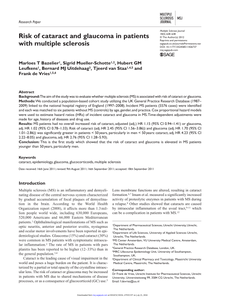BackgroundPhysical exercise in cancer patients is a promising intervention to improve cognition and increase brain volume, including hippocampal volume. We investigated whether a 6-month exercise intervention primarily impacts total hippocampal volume and additionally hippocampal subfield volumes, cortical thickness and grey matter volume in previously physically inactive breast cancer patients. Furthermore, we evaluated associations with verbal memory.MethodsChemotherapy-exposed breast cancer patients (stage I-III, 2–4 years post diagnosis) with cognitive problems were included and randomized in an exercise intervention (n = 70, age = 52.5 ± 9.0 years) or control group (n = 72, age = 53.2 ± 8.6 years). The intervention consisted of 2x1 hours/week of supervised aerobic and strength training and 2x1 hours/week Nordic or power walking. At baseline and at 6-month follow-up, volumetric brain measures were derived from 3D T1-weighted 3T magnetic resonance imaging scans, including hippocampal (subfield) volume (FreeSurfer), cortical thickness (CAT12), and grey matter volume (voxel-based morphometry CAT12). Physical fitness was measured with a cardiopulmonary exercise test. Memory functioning was measured with the Hopkins Verbal Learning Test-Revised (HVLT-R total recall) and Wordlist Learning of an online cognitive test battery, the Amsterdam Cognition Scan (ACS Wordlist Learning). An explorative analysis was conducted in highly fatigued patients (score of ≥ 39 on the symptom scale ‘fatigue’ of the European Organisation for Research and Treatment of Cancer Quality of Life Questionnaire), as previous research in this dataset has shown that the intervention improved cognition only in these patients.ResultsMultiple regression analyses and voxel-based morphometry revealed no significant intervention effects on brain volume, although at baseline increased physical fitness was significantly related to larger brain volume (e.g., total hippocampal volume: R = 0.32, B = 21.7 mm3, 95 % CI = 3.0 – 40.4). Subgroup analyses showed an intervention effect in highly fatigued patients. Unexpectedly, these patients had significant reductions in hippocampal volume, compared to the control group (e.g., total hippocampal volume: B = −52.3 mm3, 95 % CI = −100.3 – −4.4)), which was related to improved memory functioning (HVLT-R total recall: B = −0.022, 95 % CI = −0.039 – −0.005; ACS Wordlist Learning: B = −0.039, 95 % CI = −0.062 – −0.015).ConclusionsNo exercise intervention effects were found on hippocampal volume, hippocampal subfield volumes, cortical thickness or grey matter volume for the entire intervention group. Contrary to what we expected, in highly fatigued patients a reduction in hippocampal volume was found after the intervention, which was related to improved memory functioning. These results suggest that physical fitness may benefit cognition in specific groups and stress the importance of further research into the biological basis of this finding.
MULTIFILE

Purpose: To establish age-related, normal limits of monocular and binocular spatial vision under photopic and mesopic conditions. Methods: Photopic and mesopic visual acuity (VA) and contrast thresholds (CTs) were measured with both positive and negative contrast optotypes under binocular and monocular viewing conditions using the Acuity-Plus (AP) test. The experiments were carried out on participants (age range from 10 to 86 years), who met pre-established, normal sight criteria. Mean and ± 2.5σ limits were calculated within each 5-year subgroup. A biologically meaningful model was then fitted to predict mean values and upper and lower threshold limits for VA and CT as a function of age. The best-fit model parameters describe normal aging of spatial vision for each of the 16 experimental conditions investigated. Results: Out of the 382 participants recruited for this study, 285 participants passed the selection criteria for normal aging. Log transforms were applied to ensure approximate normal distributions. Outliers were also removed for each of the 16 stimulus conditions investigated based on the ±2.5σ limit criterion. VA, CTs and the overall variability were found to be age-invariant up to ~50 years in the photopic condition. A lower, age-invariant limit of ~30 years was more appropriate for the mesopic range with a gradual, but accelerating increase in both mean thresholds and intersubject variability above this age. Binocular thresholds were smaller and much less variable when compared to the thresholds measured in either eye. Results with negative contrast optotypes were significantly better than the corresponding results measured with positive contrast (p < 0.004). Conclusions: This project has established the expected age limits of spatial vision for monocular and binocular viewing under photopic and high mesopic lighting with both positive and negative contrast optotypes using a single test, which can be implemented either in the clinic or in an occupational setting.
DOCUMENT

The aim of the study was to evaluate whether multiple sclerosis (MS) is associated with risk of cataract or glaucoma. We conducted a population-based cohort study utilizing the UK General Practice Research Database (1987–2009) linked to the national hospital registry of England (1997–2008). Incident MS patients (5576 cases) were identified and each was matched to six patients without MS (controls) by age, gender, and practice. Cox proportional hazard models were used to estimate hazard ratios (HRs) of incident cataract and glaucoma in MS. Time-dependent adjustments were made for age, history of diseases and drug use.
DOCUMENT
